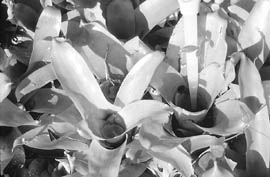Mosquitos in your Garden
By Phil Lounibos and George O'Meara
A summer trip to Everglades National Park can provide a disquieting glimpse of South Florida without mosquito control or the protection of screened enclosures. The same salt marsh mosquito, Aedes taeniorhynchus, that ravages visitors to the Everglades often irritates gardeners who live near their brackish breeding grounds.
However, you will not avoid mosquitoes by living far from the Everglades. Other species complete their entire life cycles in gardens, with immature insects developing in the water caught by terrestrial plants. Even such infamous transmitters of viruses as the yellow fever mosquito Aedes aegypti and the Asian tiger mosquito Aedes albopictus can be found in plant-held water, although these species more commonly occupy artificial container habitats.
The small water bodies held by terrestrial plants are known as phytotelmata, derived from the Greek roots for plant and pond. They occur in more than 1,500 species in 29 plant families. The most common phytotelmata are leaf axils. Aquatic insects and mosquitoes, in particular, are the predominant inhabitants of phytotelmata. Often plants grown as ornamentals, such as species of Dracaena, Crinum, Pandanus and Euphorbia, harbor enough water in their axils for mosquito larval development, and the axils of many economically important plants such as cocoyams, pineapple, and banana support a specialized mosquito fauna.
Bromeliad axils support more insect life than any other phytotelmata throughout much of the Neotropics. In South Florida, two native mosquito species of the genus Wyeomyia occur in the axils of some Tillandsias; these same mosquitoes readily colonize exotic bromeliads. Recently, a previously undescribed species of Culex mosquito was discovered breeding in exotic bromeliads in Coral Gables. Whether it was an accidentally introduced species or a long-term, undetected resident remains to be determined.
Leaves modified into fluid-holding cups, such as those of the insectivorous pitcher plants of the genera Sarracenia and Heliamphora, form phytotelmata. Although these carnivorous plants derive nutrients from drowned insects broken down in their pitcher liquor, the immature stages of several mosquito species thrive in the same medium. Among the insectivorous phytotelmata, large Nepenthes pitchers (structurally are modified tendrils) support the most diverse aquatic communities.
Some flower bracts, such as those of species of Heliconia, Curcuma and Zingiber, hold enough water that in their native land, they nurture a specialized mosquito fauna. However, when the same plants are grown in Florida, the specialist mosquito species that evolved as colonists of these tiny microhabitats are usually not present. The hollow stems of woody plants, such as in species of Calathea or the bamboos also form phytotelmata. The most widespread and long-lived of phytotelmata are treeholes in hardwood trees. In a hammock at our laboratory in Vero Beach, treeholes in live oaks have held mosquitoes for a 20 year observation period (except during infrequent droughts).
Mosquitoes use plants in diverse ways besides as water containers for their young. For example, mosquitoes of the genus Mansonia deposit their eggs in masses on aquatic macrophytes, such as water hyacinth or water lettuce. Their larvae and pupae obtain air from the root systems of these host plants, so the immature mosquitoes don't need to swim to the surface. The close associations of larvae and pupae of permanent-water mosquitoes with aquatic plants afford them some protection from predators. Mosquitoes also use nectar as a source of sugars metabolized to sustain flight. Although only female mosquitoes consume blood, both sexes regularly visit flowers.
Mosquito control in gardens depends on many factors, including the sources and annoyance levels of the biting pests. Plant pots, drainage dishes, and bird baths should be cleaned out or overturned if mosquito larvae and pupae are present. The Wyeomyia mosquitoes that inhabit phytotelmata are not usually significant pests in South Florida, but target-specific, slow-release larvicides can be used in large, exotic bromeliads. If your garden includes a pond, larvivorous fish and the removal of leaf litter will reduce mosquito production. However, if you live near salt marsh habitats, your only option may be to apply repellent.
Both authors are professors at the University of Florida's Florida Medical Entomology Laboratory in Vero Beach where they do research on the biology of mosquitoes.
Reprinted from Garden News, November 1998

